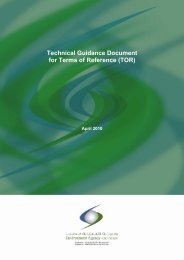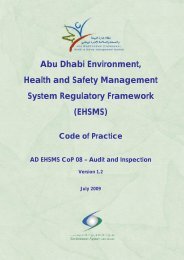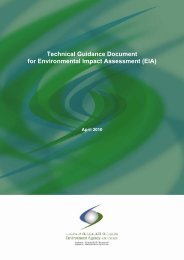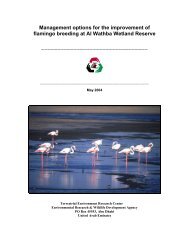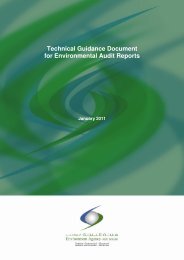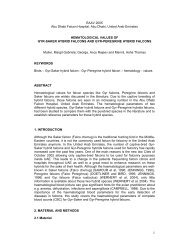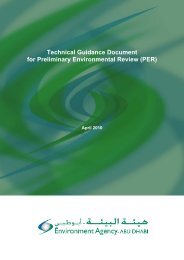Technical Guidance Document for Environmental Action Plan (EAP)
Technical Guidance Document for Environmental Action Plan (EAP)
Technical Guidance Document for Environmental Action Plan (EAP)
Create successful ePaper yourself
Turn your PDF publications into a flip-book with our unique Google optimized e-Paper software.
<strong>Technical</strong> <strong>Guidance</strong> <strong>Document</strong> <strong>for</strong> <strong>Environmental</strong> <strong>Action</strong> <strong>Plan</strong><br />
1.2 Site Activities<br />
Site activities should provide an overview of the current activities at the site, with a focus on those<br />
activities that have the potential to create environmental impacts. At a minimum, the overview should<br />
include the name of each operation, any hazard presented, the names of hazardous materials used, the<br />
environmental aspect, and a description of any actual or potential impact. Where appropriate, process<br />
flowcharts, site maps, and photographs should be included in the <strong>EAP</strong> to provide sufficient detail on<br />
the site activities so that EAD can assess the nature of a problem finding and any proposed corrective<br />
action.<br />
1.3 Facility/Project Inspection/Audit Program<br />
The process <strong>for</strong> the identification and reporting of problem findings that is implemented at the<br />
facility/site should be documented and include the following in<strong>for</strong>mation:<br />
• The purpose, objectives, and scope of the overall problem identification process<br />
• The frequency of internal and external inspections or audits and internal/external parties<br />
involved in per<strong>for</strong>ming the inspections<br />
• The entity (e.g., external consultant, EAD) that per<strong>for</strong>med the inspection <strong>for</strong> which the <strong>EAP</strong> is<br />
being developed with detailed in<strong>for</strong>mation on the scope of the inspection per<strong>for</strong>med<br />
• The methods <strong>for</strong> collecting, preserving, analyzing, and documenting in<strong>for</strong>mation concerning<br />
the identified finding(s)<br />
• The procedures <strong>for</strong> communicating the results of the identified findings (i.e., written and oral)<br />
to those organisations and individuals affected. Results of these assessments and<br />
investigations should be thoroughly documented to provide clear, factually accurate<br />
in<strong>for</strong>mation on the purpose; scope; results, including positive attributes, opportunities <strong>for</strong><br />
improvement, and problem findings; and conclusions.<br />
2. Summary of Problem Findings<br />
The <strong>EAP</strong> should provide descriptions of the source of the findings <strong>for</strong> which the <strong>EAP</strong> is being<br />
developed (e.g., inspection, audit, suggestion, incident) and each reported problem. The description<br />
should include additional background in<strong>for</strong>mation on the problem to allow evaluation of the nature<br />
and extent of the deficiency. The in<strong>for</strong>mation included should also describe how long the deficiency is<br />
known to have existed and if there is an ongoing release or exposure or a threat of a release or<br />
exposure. To the extent that in<strong>for</strong>mation is available in an inspection or incident report, a copy of the<br />
report should be included; at minimum, all pertinent details should be included so that EAD can<br />
determine if the corrective actions are appropriate to resolve the issue.<br />
For example, it would not be sufficient to state, “Hazardous waste is improperly stored at the facility.”<br />
An appropriate description would include the container size, content, location, and quantity of<br />
improperly stored hazardous waste, as well as a description of the improper storage practice, the<br />
reason <strong>for</strong> the practice, and the duration of the activity. Table 2 provides additional examples of<br />
appropriate descriptions of findings.<br />
Table 2. Examples of Descriptions of Findings<br />
Finding<br />
Improper training documentation<br />
Containers not appropriately<br />
labelled<br />
Description<br />
Training provided <strong>for</strong> workers using and handling hazardous materials or<br />
hazardous waste during safety meetings was not documented.<br />
The labels of several drums of acetone and other solvents in the paint<br />
booth area are in a language that is not consistent with the native<br />
language of the workers.<br />
6





